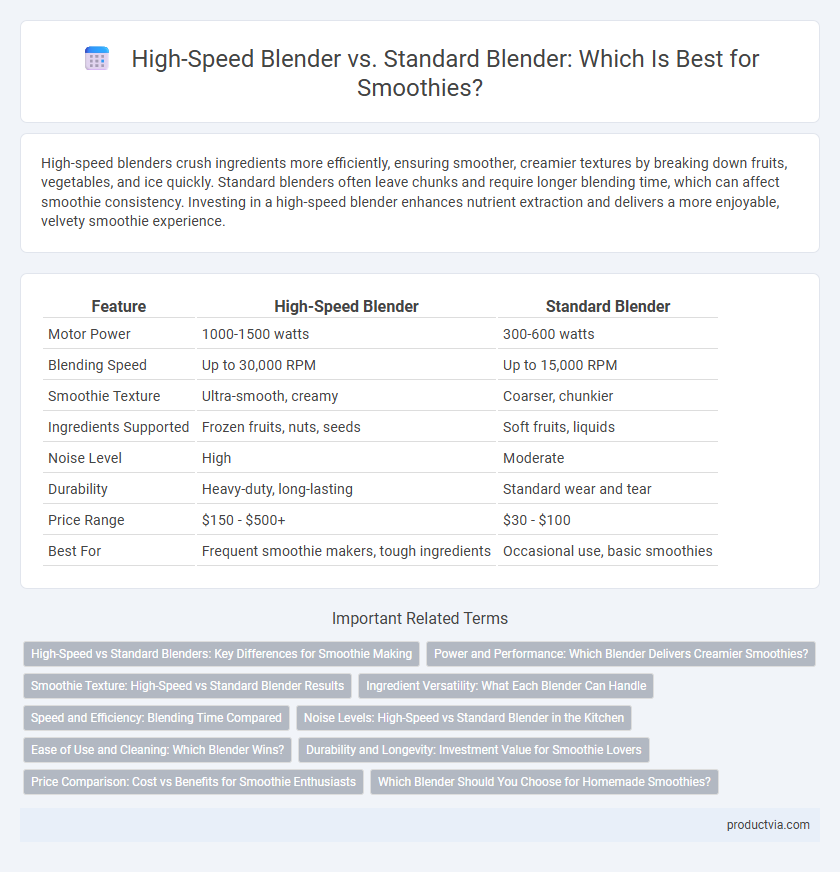High-speed blenders crush ingredients more efficiently, ensuring smoother, creamier textures by breaking down fruits, vegetables, and ice quickly. Standard blenders often leave chunks and require longer blending time, which can affect smoothie consistency. Investing in a high-speed blender enhances nutrient extraction and delivers a more enjoyable, velvety smoothie experience.
Table of Comparison
| Feature | High-Speed Blender | Standard Blender |
|---|---|---|
| Motor Power | 1000-1500 watts | 300-600 watts |
| Blending Speed | Up to 30,000 RPM | Up to 15,000 RPM |
| Smoothie Texture | Ultra-smooth, creamy | Coarser, chunkier |
| Ingredients Supported | Frozen fruits, nuts, seeds | Soft fruits, liquids |
| Noise Level | High | Moderate |
| Durability | Heavy-duty, long-lasting | Standard wear and tear |
| Price Range | $150 - $500+ | $30 - $100 |
| Best For | Frequent smoothie makers, tough ingredients | Occasional use, basic smoothies |
High-Speed vs Standard Blenders: Key Differences for Smoothie Making
High-speed blenders feature powerful motors typically ranging from 1000 to 3000 watts, enabling them to crush ice, blend frozen fruits, and create silky-smooth textures more efficiently than standard blenders which usually have motors under 700 watts. High-speed blenders utilize advanced blade designs and variable speed settings to ensure thorough blending and nutrient extraction, while standard blenders often struggle with fibrous ingredients and produce chunkier smoothies. Investing in a high-speed blender enhances smoothie quality by delivering consistently smooth, creamy results and faster blending times compared to standard models.
Power and Performance: Which Blender Delivers Creamier Smoothies?
High-speed blenders typically feature motor power ranging from 1000 to 1800 watts, enabling faster blade rotation and smoother texture in smoothies compared to standard blenders with 300 to 600 watts. The enhanced RPM (revolutions per minute) of high-speed blenders breaks down tough ingredients like frozen fruits and leafy greens more efficiently, resulting in creamier, lump-free blends. Performance metrics consistently show high-speed blenders excel in delivering velvety, well-integrated smoothie blends due to superior torque and blade design.
Smoothie Texture: High-Speed vs Standard Blender Results
High-speed blenders achieve smoother, creamier textures by blending fruits and ice into a uniformly fine consistency, eliminating chunks and fibrous bits often left by standard blenders. Standard blenders may struggle with dense ingredients, resulting in a coarser, sometimes grainy smoothie texture. The powerful motors and superior blade designs in high-speed blenders allow for efficient breaking down of tough ingredients, making them ideal for silky smoothies.
Ingredient Versatility: What Each Blender Can Handle
High-speed blenders excel in handling a wide range of ingredients including tough greens, frozen fruits, nuts, and seeds, creating smoother and creamier smoothies with enhanced nutrient extraction. Standard blenders perform well with softer fruits and liquids but may struggle with fibrous vegetables or ice, resulting in chunkier textures. Ingredient versatility in high-speed blenders provides greater flexibility for diverse smoothie recipes, accommodating complex blends that standard blenders cannot efficiently process.
Speed and Efficiency: Blending Time Compared
High-speed blenders consistently outperform standard blenders in blending time, often completing smoothies in 30 to 60 seconds compared to several minutes with standard models. Their powerful motors, typically ranging from 1000 to 1500 watts, enable faster ingredient breakdown and smoother textures. Efficient blade design and higher RPMs, sometimes exceeding 20,000 RPM, reduce blending time while preserving nutrients and flavor in smoothies.
Noise Levels: High-Speed vs Standard Blender in the Kitchen
High-speed blenders typically generate more noise due to powerful motors that can reach over 90 decibels, compared to standard blenders which usually operate around 70-80 decibels. The noise level difference is significant when blending tough ingredients for smoothies, making high-speed blenders potentially disruptive in quiet kitchen environments. Choosing a standard blender can reduce noise but may compromise on blending efficiency and smooth texture for fibrous fruits and ice.
Ease of Use and Cleaning: Which Blender Wins?
High-speed blenders feature intuitive controls and pre-programmed settings that simplify smoothie preparation, making them easier to use compared to standard blenders with manual dials. Their self-cleaning functions and removable, dishwasher-safe parts significantly reduce cleaning time and effort. Standard blenders often require more manual intervention for both blending and cleaning, giving high-speed blenders a clear advantage in ease of use and maintenance.
Durability and Longevity: Investment Value for Smoothie Lovers
High-speed blenders feature robust motors and reinforced blades designed to handle tough ingredients, significantly enhancing their durability and longevity compared to standard blenders. Investing in a high-speed blender offers smoothie lovers a reliable appliance that withstands frequent use without compromising performance or requiring frequent replacements. This durable construction translates to better long-term value, making it a cost-effective choice for maintaining optimal smoothie texture and consistency.
Price Comparison: Cost vs Benefits for Smoothie Enthusiasts
High-speed blenders typically range from $200 to $600, offering powerful motors and advanced blade technology that create smoother, more consistent smoothies compared to standard blenders priced between $50 and $150. The higher upfront investment in high-speed blenders translates to enhanced nutrient extraction, better texture, and the ability to blend tougher ingredients like frozen fruits and leafy greens efficiently. For smoothie enthusiasts prioritizing texture and nutrition, the cost-benefit balance favors high-speed blenders despite the premium price, while casual users might find standard blenders adequate for basic blending tasks.
Which Blender Should You Choose for Homemade Smoothies?
High-speed blenders feature powerful motors exceeding 1000 watts and blade designs that pulverize frozen fruits and fibrous vegetables into ultra-smooth textures, making them ideal for creamy homemade smoothies. Standard blenders typically offer lower wattage and struggle to fully blend tough ingredients, often resulting in a chunkier consistency that may require longer blending times. Choosing a high-speed blender enhances nutrient extraction and texture, delivering a restaurant-quality smoothie experience at home.
High-speed blender vs standard blender for smoothies Infographic

 productvia.com
productvia.com